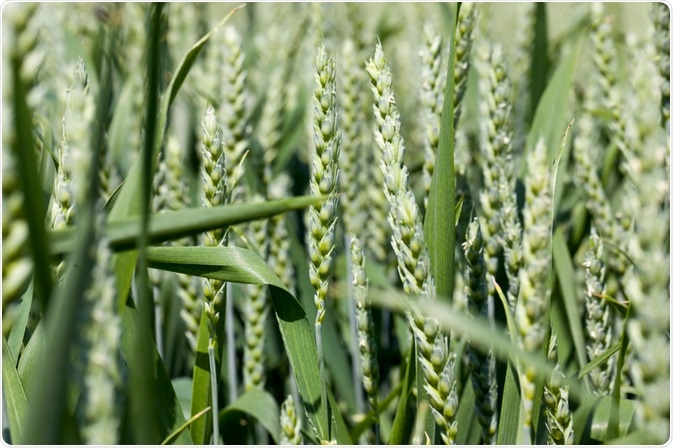The world's growing population is expected to be 10 billion in the next thirty years. Such an increment in the human population posed a lot of pressure on plant scientists to fulfill food needs. Along with population growth, climate change is also a major challenge to food availability. Thus, the only solution for food security and availability is speed breeding.

Rye Crop. Image Credit: rsooll/Shutterstock.com
Speed breeding shortens the breeding cycle of crops and accelerates their breeding generation cycle per year. Speed breeding techniques can be used to achieve maximum generations of crops per year. The term "speed breeding" is an inspiration of the NASA project and was coined by researchers at the University of Queensland.
Through this technique, up to six generations of various crop species can be harvested. For example, the six-generation of wheat (Triticum aestivum) and durum wheat (Triticum durum), barley (Hordeum vulgare), chickpea (Cicer arietinum), pea (Pisum sativum), and canola (Brassica napus).
Speed breeding shortens the breeding cycle of crops and accelerates their breeding generation cycle per year. Speed breeding techniques can be used to achieve maximum generations of crops per year. The term "speed breeding" is an inspiration of the NASA project and was coined by researchers at the University of Queensland. Through this technique, up to six generations of various crop species can be harvested.
For example, the six-generation of wheat (Triticum aestivum) and durum wheat (Triticum durum), barley (Hordeum vulgare), chickpea (Cicer arietinum), pea (Pisum sativum), and four generations of canola (Brassica napus). This method involves the continuous supply of artificial light for a period of 20-22h to accelerate photosynthesis because of extended light. The extended light conditions favor photosynthesis and flowering in plants which means more generations of crop plants per year.
The recipe of speed breeding is dependent on optimum light conditions that include light intensity, quality, and length. Light exposure of twenty-two hours with two hours of darkness is optimum for growth acceleration. The darkness hour improves plant health. A team of researchers at Queensland University has also implied the importance of optimum temperature and humid conditions in speed breeding. The temperature of 17 ℃ with 22h of photoperiod is ideal with 60-70% humidity.
Speed breeding can have various effects based on plant species. For long-day plants, the extended photoperiod is favorable for the acceleration of the flowering. Because the critical day length for flowering is extended. This is also similar to day-neutral plants. But contrary to short-day plants that require shorten photoperiod for flowering. Such differences highlight the limitations of speed breeding.
Other Breeding Approaches
Another breeding technology that "increases the generation turnover" is shuttle breeding. This technology involves the growing of crops at various ecological zones. This technology was introduced by Nobel Laureate Norman Borlaug in the 1950s at the International Centre for Maize and Wheat Improvement (CIMMYT). This technique enabled the growing of two generations per year at different climate locations in Mexico.
Another approach for increasing the generation cycle is embryo rescue. This technique involves the induction of germination in immature embryos through the application of plant growth regulators (PGRs). A study has achieved four generations of lentil crop per year by embryo rescue technique. Similarly, another study has also achieved shorter generation cycles in oat. Shorter generation cycles can also be improved by higher carbon dioxide (CO2) concentrations. For example, for C3 plants (rice and wheat), the higher carbon concentrations increase the photosynthetic efficiency and induced early anthesis. This ultimately results in increased biomass in C3 plants.
Speed breeding is promising and effective because it does not involve any complicated science. And also, it shortens the number of years that were previously required by conventional breeding programs. Speed breeding could also accelerate the selection of better phenotypes and allelic diversity in cereal crop plants. Speed breeding could faster the domestication process of polyploid crops through multiple selections.
The integration of speed breeding with genome editing techniques could help in the creation of healthier food. Speed breeding could alleviate cereal diseases through the pyramiding of elite trait genes especially diseases resistance.
Crop improvements can meet the challenge of population growth and climate change. These challenges can effectively be solved by the integration of other breeding technologies with speed breeding. By keeping in mind climate change and population growth, the important aspect of plant breeding studies is the shortening of the crop generation cycle.
The objective of these studies is to meet the requirements of the ever-rising human population. By the integrations of these technologies, the food availability (food waste reduction, improved crop productivity, and reductions in yield gap through improved agronomic practices) issues could be improved.
This write-up is an inspiration from the researcher of The University of Queensland and John Innes Centre.
Sources:
- Hickey, L. T., Hafeez, A. N., Robinson, H., Jackson, S. A., Leal-Bertioli, S. C., Tester, M., ... & Wulff, B. B. (2019). Breeding crops to feed 10 billion. Nature Biotechnology, 37(7), 744-754. DOI: https://doi.org/10.1038/s41587-019-0152-9
- Watson, A., Ghosh, S., Williams, M. J., Cuddy, W. S., Simmonds, J., Rey, M. D., ... & Hickey, L. T. (2018). Speed breeding is a powerful tool to accelerate crop research and breeding. Nature plants, 4(1), 23-29. DOI: https://doi.org/10.1038/s41477-017-0083-8
[further agricultural science]
Last Updated: Jun 4, 2021